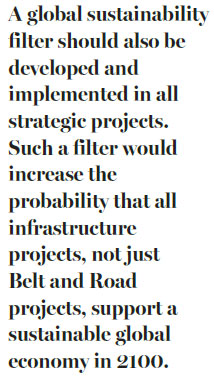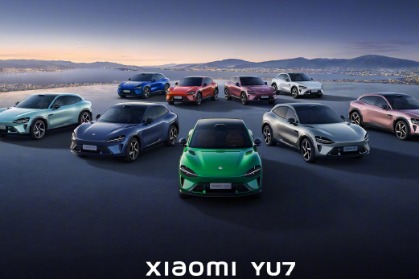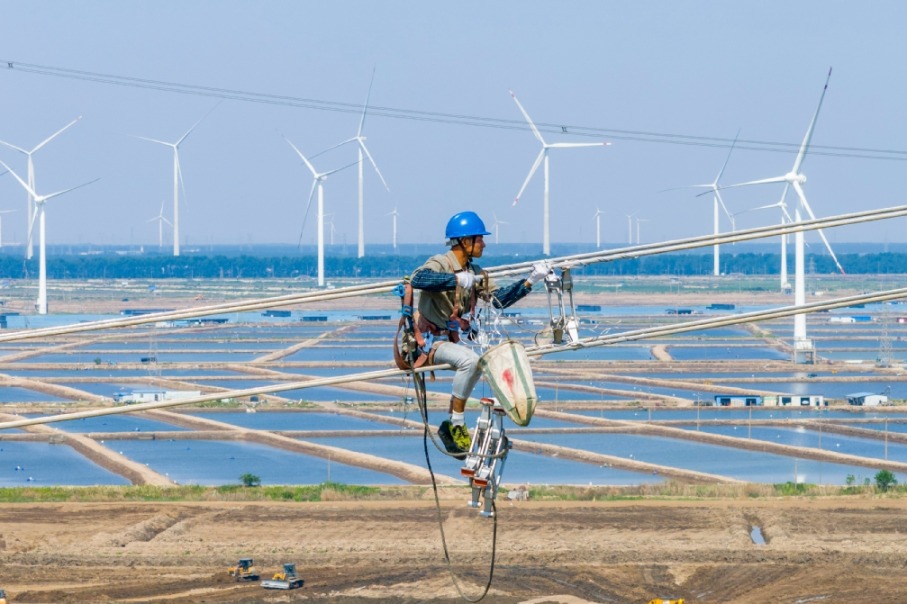Belt and Road Initiative's 'new vision'

Combined result of technological trends is the possibility of a radically different infrastructure - one that can be globally sustainable
The Belt and Road Initiative is one of the most important initiatives on the planet right now. Not because of its economic and geographical magnitude, but because of its potential to create something new and much needed. The initiative has the potential to take a significant step toward a 21st-century sustainable network that connects all countries in a way that benefits everyone on more equal terms.
In order for Belt and Road to be the first major infrastructure project to integrate a digital sustainability perspective for the 21st century, and actually deliver on the ground, global collaboration is needed.
At China's 19th National Congress of the Communist Party of China last month, the Belt and Road Initiative was included in the Party's Constitution. There now can be no doubt about the long-term commitment on the Chinese side. Minor delays and setbacks are therefore less important, but partnerships that support the initiative's ambitious agenda, especially the sustainability and digitalization agenda, are needed. Here, the European Union could play an important role, especially in central and eastern areas where significant investment will occur.
At the Belt and Road Forum for International Cooperation in Beijing in May, President Xi Jinping summarized the sustainability and digitalization aspect of Belt and Road in the following way:
For sustainability, "we should pursue the new vision of green development and a way of life and work that is green, low-carbon, circular and sustainable. Efforts should be made to strengthen cooperation in ecological and environmental protection and build a sound ecosystem so as to realize the goals set by the (United Nations') 2030 Agenda for Sustainable Development."

For digitalization, he said, "we should pursue innovation-driven development and intensify cooperation in frontier areas such as digital economy, artificial intelligence, nanotechnology and quantum computing, and advance the development of big data, cloud computing and smart cities so as to turn them into a digital silk road of the 21st century."
An infrastructure project with such an approach to sustainability and digitalization is very different from what we see today around the world, including in the EU and China.
In the same way as we cannot any longer only think of paper books in a world with e-books, or CDs in a world where it is possible to stream music, we cannot think of roads, bridges and tunnels only as physical constructions. We need to include all-new sustainable ways that can provide the service the old infrastructure used to provide.
Today, people can have meetings virtually and work remotely, and we are just in the beginning of a revolution with additive manufacturing. Rapid technological development in key areas allows goods and people to move in new ways, from drones to ultra-high-speed trains. The combined result of trends like these is the possibility of a radically different infrastructure, one that can be globally sustainable.
We must ask what goods must move physically, what can be produced more efficiently locally, what can be dematerialized, and what can use new smart means of transportation, in order to ensure global sustainability and fair economic development.
Further, the physical infrastructure must merge with the digital. A smart resource-efficient and fossil-free physical infrastructure can even be a net producer of renewable energy in many cases.
For international collaboration to happen, it is important that the vision and goals of the Belt and Road Initiative are communicated; a dedicated webpage would be appropriate. On this webpage, different aspects, including digitalization and sustainability, but also peace, prosperity and innovation, could be reported in close to real time. This would allow interested stakeholders to help improve and access relevant information.
A global sustainability filter should also be developed and implemented in all strategic projects. Such a filter would increase the probability that all infrastructure projects, not just Belt and Road projects, support a sustainable global economy in 2100. This future world is likely to include at least 11 billion people, must emit no greenhouse gas emissions, and must be based on a sustainable and equitable use of natural resources.
If the Belt and Road Initiative contributes to such global sustainability, it will be a physical and digital road toward an ecological civilization.
The author is founder of Sweden-based consultancy 21st Century Frontiers. The views do not necessarily reflect those of China Daily.
(China Daily European Weekly 11/24/2017 page9)
Today's Top News
- Xi calls for upholding of ethnic unity
- Abuse of 'security' stifles innovation, collaboration
- Beijing warns countries against signing trade deals with US that hurt Chinese interests
- AI shouldn't undermine humanity's progress
- Xi urges villagers in Xizang to uphold ethnic solidarity
- Digital tax sparks breakdown in US-Canada trade talks






























